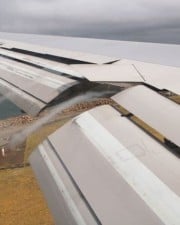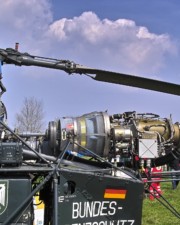Of all the questions asked by airplane enthusiasts, one of the most basic and most interesting questions is, what type of fuel does an airplane use? After all, it can’t run on regular gasoline like cars do – or can it? If you’ve ever been curious about the type of fuel that is needed to operate an airplane, wonder no more, because following is a description of all of these types to answer this question.
Table of Contents
What Affects the Type of Fuel Used in an Airplane?
If you’re curious about what determines the type of fuel used by an airplane, the answer is simple: the fuel type is a direct result of the type of engine used in that plane. Simply put, commercial and fighter planes tend to use kerosene-based fuel, but certain products are usually added to the fuel. This includes antifreeze, hydrocarbons, metal deactivators, and antioxidants, all of which prevent corrosion and freezing at higher altitudes, to name a few.
Although there are blends and mixtures of airplane fuel, it all begins with three basic types, and they are described below.
Kerosene-Based Aircraft Fuels
Kerosene-based fuel for airplanes is usually broken down into various types, according to physical qualities and certain specifications. These types include:
- Jet A:
Only available in the United States, Jet A fuel was developed to be heavy, with a higher flash point and higher freezing point than standard kerosene. This fuel has low vapor pressure and a flash point that is roughly 110ᵒ Fahrenheit. - Jet A1:
Most turbine-engine aircraft use this type of fuel. It has a flash point of 100ᵒ Fahrenheit and a maximum freeze point of -52ᵒ Fahrenheit. It is an easy fuel to find if you’re located outside of the United States. - Jet B:
Also called wide-cut fuel because it is a combination of kerosene and gasoline, it is used mostly in areas that experience very cold weather, in part because its freezing point is around -76ᵒ Fahrenheit. Its vapor pressure is somewhere between that of gasoline and kerosene.

Military-Based Fuels
There are eight different types of military-based airplane fuel, as described below.
- JP-1:
This fuel is pure kerosene and has a freezing point of -76ᵒ Fahrenheit. Even though it was efficient fuel, it was soon replaced by other types of wide-cut jet fuel, including fuels made from kerosene-naphtha and a kerosene-gasoline mixture. - JP-2 and JP-3:
JP-2 was originally developed to replace JP-1 fuel and was rarely used. JP-2 fuel had a high freezing point, but was eventually replaced by JP-3, which was more volatile and was supposed to improve the former. However, because both of these fuels had high vapor loss and were unstable, neither are being used today. - JP-4:
This type of fuel is flammable and transparent, with a clear or straw color and a smell similar to kerosene. In addition, the JP-4 fuel floated on water and easily evaporated. It had such a low flash point (0ᵒ Fahrenheit) that a match dropped in it would not ignite, and its maximum water temperature was 6,670ᵒ Fahrenheit. - JP-5:
The JP-5 fuel is yellow in color and contains ingredients such as hydrocarbons, naphthenes, alkenes, and aromatic hydrocarbons. It has a high flash point of 140ᵒ Fahrenheit and a freeze point of -51ᵒ Fahrenheit, and it contains no antistatic agents. - JP-6:
This fuel was developed specifically for the General Electric YJ 93 Jet Engine associated with the XB-70 Valkyrie Supersonic Aircraft, a high-altitude bomber plane. It was similar to the JP-5 fuel except its freeze point was -65ᵒ Fahrenheit. It also had better thermal oxidative stability than the JP-5. - JP-7:
This fuel copes well with the heat and stress associated with high-speed supersonic flights, in part because of its high flash point. It was specifically developed for the twin Pratt & Whitney J58 Turbojet/Ramjet engines of the SR-71 Blackbird. - JP-8:
The JP-8 fuel is similar to the A1 fuel utilized by many commercial airlines, and it has been widely used by the U.S. military. Ingredients were added to it for corrosion barrier and anti-icing purposes, and it has a freezing point of -52ᵒ Fahrenheit, as well as a flash point of 100ᵒ Fahrenheit.

AvGas Fuel
This is a very popular type of airplane fuel that is often used by small piston-powered aircraft. It is specifically used for tasks such as crop-dusting and for private flying, flying clubs, and even flight training.
AvGas fuel works on these planes because their pistons work much like those in car engines, and the fuel itself works much like gasoline does on these systems, although the two fuels themselves are different.
AvGas fuel is a safe, stable, and predictable fuel that promises great performance regardless of the conditions, and its formulation is a bit different than the regular gasoline that is used in most cars.
It comes in many different grades and normally has octane ratings that are much higher than those of regular gasoline.

When Producing Aviation Fuel
When aviation fuel is developed, it normally falls into one of two categories – fuel suitable for turbine engines and fuel suitable for internal combustion engines. For each of these types, there are international specifications required.
For instance, in both turboprop and jet aircraft, jet fuel is used because it has low viscosity at low temperatures and burns clean, is limited in density and calorific value, and remains stable even when heated to high temperatures.
All of these characteristics are crucial when it comes to the right aviation fuel.
AvGas, which stands for aviation gasoline, is made from a very refined type of regular gasoline. It is pure, has anti-knock properties, and minimizes fouling of the spark plugs.
In addition, this type of gas has both the right mixture condition for takeoff power settings and the leaner mixture condition needed for the cruise phase when reduced fuel consumption is important.
As a general rule, much less AvGas is sold than jet fuel, although a lot of independent aircraft carriers use it.
Conversely, large aircraft companies, including commercial airlines and the military, tend to use jet fuel instead of AvGas.

The Wave of the Future
In addition to these types of airplane fuel, research is promising to produce newer and even better types of fuel in the future. This is partly because most fuels are fossil-based and, therefore, not sustainable or clean.
In fact, a more sustainable type of fuel for both airplanes and vehicles is the goal of many of these research companies, and below are a few of the more promising developments.
- Biofuels:
These include fuels made from the biomass-to-liquid method and encompass certain sustainable aviation fuel (SAF) and even vegetable oil.
Some advantages associated with SAF include the fact that when used, there is little to no changes required to the aircraft itself.
Some SAFs include small amounts of fossil fuels mixed into them, and they offer lower GHG and particle emission levels.
However, most biofuels are higher in price than other types of aviation fuel, and they face enormous economic and political complications that hinder their use. - Compressed Natural Gas/Liquefied Natural Gas:
Both compressed natural gas (CNG) and liquefied natural gas (LNG) have low specific energy, making them a disadvantage for flight applications.
Still, some aircraft – including one used by NASA’s N+4 Advanced Concept Development Program – were made specifically to use one or more of these types of natural gas.
Related Posts












